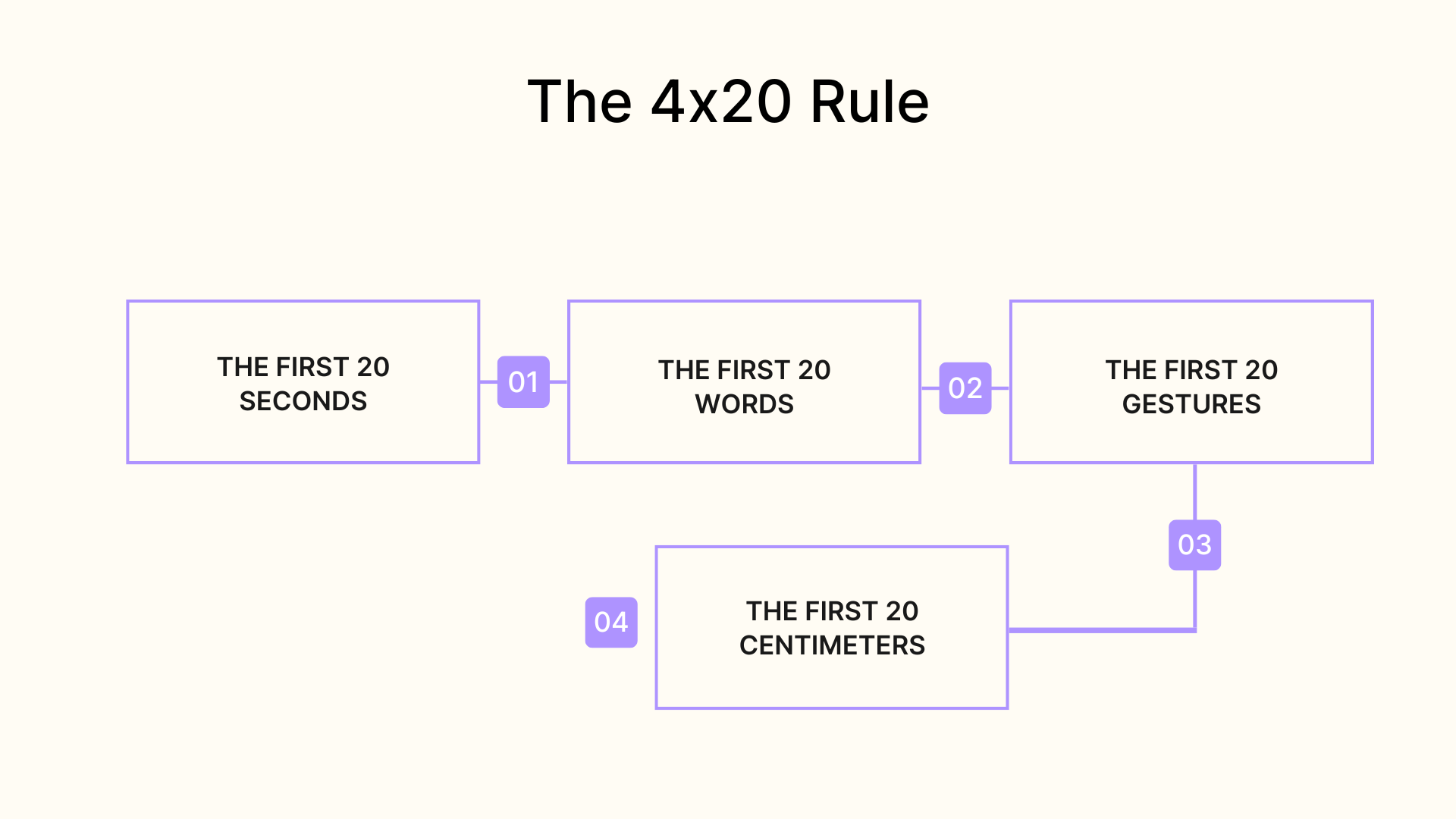Master the 4x20 Rule to Transform Your Sales Contacts into Deals
The 4x20 rule represents a proven method for maximizing the impact of your initial sales contacts. This structured approach breaks down the key moments of a professional encounter into four sequences of 20: seconds, words, gestures, and centimeters. Mastering these four dimensions allows you to create an authentic connection with your prospects and quickly establish a climate of trust conducive to closing deals.
- The 4x20 rule emphasizes the critical importance of first impressions during sales contacts, as these form within just a few seconds.
- It structures this crucial phase around 4 elements to master: the first 20 seconds (appearance, smile), the first 20 words (hook, tone), the first 20 gestures (posture, non-verbal), and the first 20 centimeters (distance management).
- The main objective is to immediately create a climate of trust, an authentic connection, and establish professional credibility from the start of the interaction.
- This method is applicable and adaptable to different contexts: in-person meetings, video conferences, and even phone calls (focusing on voice).
The fundamental principles of the 4x20 method
The origin of this effective sales technique
The 4x20 rule has its roots in the 1980s, when sales technique experts identified the decisive impact of first impressions on sales success. This method developed in response to observations of top performers who naturally succeeded in creating strong connections from the very first moments.
Behavioral psychology research has demonstrated that a potential customer forms an opinion in less than 30 seconds. Faced with this reality, sales trainers codified these instinctive practices into a systematic approach, creating the 4x20 rule.
The digitalization of exchanges has modernized its application, but the fundamental principles remain relevant for any sales interview, whether physical or virtual.
Why the 4x20 rule is essential
Recent data reveals that 85% of successful sales are decided within the first minutes of client contact. This reality places the 4x20 rule at the heart of modern sales performance.
A salesperson mastering this approach increases their conversion rate by 25% on average. The reason? The human brain evaluates an interlocutor's credibility in just a few seconds.
The 4x20 rule structures this decisive phase of client contact into precise and measurable sequences:
- Adapted body language reinforces trust (see persuasion levers like CAP SONCAS)
- Chosen words create an immediate connection (align them with the customer-centric 4C model)
- Appropriate gestures confirm professionalism
- Optimal distance ensures relational comfort
The objectives of the 4x20 method in client relations
The 4x20 method aims to create positive dynamics from the first exchanges with your interlocutor. Its methodical application allows for establishing a climate conducive to mutual listening and constructive dialogue.
Mastered eye contact, combined with open gestures and simple vocabulary, naturally reinforces your prospect's trust. This structured approach transforms every encounter into an opportunity for authentic exchange.
The central objective remains adapting your communication to the prospect's specific needs. For example, facing a busy decision-maker, you'll focus your first words on concrete benefits, while an analytical interlocutor will appreciate a more detailed presentation of your approach. In both cases, a quick qualification using BANT or BEBEDC helps you tailor the depth and direction of the conversation from the start.

4x20: The first 20 seconds - The art of first contact
How to optimize your entrance impact
Appropriate attire adapted to your interlocutor forms the foundation of a successful entrance. A tech sector salesperson will favor a business casual style, while an automotive seller will adopt more formal attire. A genuine smile represents your best asset for creating an instant connection. Combined with an open facial expression and mastered opening gestures, it naturally reinforces your credibility. Your expertise also manifests in managing personal space. Maintain a comfortable distance of about 4 feet during the handshake, then adjust according to your interlocutor's reactions. Think about the background during video conference appointments: a professional and organized space reinforces your expert image.
If the contact happens by phone, the same first-impression logic applies in cold calling: your tone, opening line, and immediate relevance make or break the next minutes.
Mistakes to avoid in the first moments
Closed signals can sabotage your entrance. Avoid crossing your arms or keeping your hands in your pockets - these gestures convey a lack of engagement. Verbal communication deserves particular attention. Ban standardized polite formulas that sound fake and overly commercial opening lines. A fleeting gaze or one fixed on your mobile phone transmits a message of disinterest. Focus on your interlocutor's face without staring them down. Adopt a natural rhythm: neither rushed as if you want to finish quickly, nor too slow at the risk of losing attention. A telling example: take time to put away your phone before entering the meeting room.
.png)
Techniques to capture attention immediately
Adopt a personalized approach from the first exchanges. Quickly analyze your interlocutor's profile on professional social networks before the meeting to adapt your speech to their business sector. A striking hook based on your prospect's specific challenges maximizes your intervention's impact. For example, mention recent news from their company or a problem specific to their market. Master the art of strategic questioning to engage in conversation. A targeted open question about your interlocutor's current challenges demonstrates your expertise and understanding of their professional environment. Use the 5 Whys to dig into root causes without sounding interrogative. Use storytelling sparingly: a short and relevant anecdote related to your prospect's business sector can create a memorable connection.
4x20: The first 20 words - How to structure your message
Choosing words for impactful communication
The careful selection of your vocabulary determines your message's impact. Prioritize action verbs that demonstrate your ability to deliver tangible results: "increase," "optimize," "transform." Adapt your language to your interlocutor's business sector. A CFO will be sensitive to profitability-related terms (e.g., ARPU and ARR), while a marketing manager will appreciate vocabulary centered on customer engagement and retention (keeping an eye on churn).
Here are word categories to integrate into your exchanges:
- Trigger words: "solution," "benefits," "results"
- Valorizing expressions: "your expertise," "your objectives"
- Unifying terms: "collaboration," "partnership," "synergy"
Ban negative or hesitant formulations like "maybe" or "try." Replace them with positive affirmations that reinforce your credibility.
Building a memorable hook
A high-performing hook is built in three stages: a market observation, a specific problem, and a value promise. A B2B salesperson could start with, "Facing rising energy costs, industrial companies are looking to optimize their consumption." The AIDA structure maximizes your message's impact: Attention, Interest, Desire, Action. Start with a striking sector figure, continue with business challenges, then propose a concrete solution. Test your hooks on your website before your appointments. Measure their effectiveness through the engagement rates of sent emails. This scientific approach is your main asset for refining your message.
The importance of tone and rhythm
Mastering your voice represents a decisive asset in sales communication. A dynamic and passionate tone naturally transmits your enthusiasm to your interlocutor. Voice modulation creates a musicality that maintains attention: alternate more energetic passages with calmer moments. Speaking rhythm adapts to each situation. Facing a busy decision-maker, adopt a sustained pace without rushing. For a technical presentation, strategically slow down on key points. Breathing plays a central role in voice mastery. A well-placed pause before major information reinforces its impact. For example, mark a pause after mentioning a significant figure, giving your interlocutor time to grasp its significance.
The first 20 gestures: Body language
Gestures that inspire trust in negotiation
Mastered gestures naturally reinforce your credibility with a prospect. Open palms facing upward convey transparency and honesty during your sales exchanges. Maintain balanced eye contact, neither too insistent nor fleeting. A stable gaze for 4 to 5 seconds establishes an authentic connection before naturally moving your attention. Your posture should remain straight without rigidity. Relaxed shoulders and a torso slightly inclined toward your interlocutor show your sincere interest. Avoid abrupt or repetitive gestures that betray nervousness. An occasional head nod shows your active listening, while a measured smile softens your words during delicate negotiation phases.
Synchronization between speech and gesture
Mastering the timing between your words and movements naturally amplifies your message's impact. A harmonious rhythm is created when your gestures accompany your key words rather than preceding or following them. Take the example of a pricing presentation: your hand opens progressively while you state the advantages, then closes gently on the pen when addressing the price. This fluidity reinforces your speech's coherence. Vary your movements' amplitude according to your words' energy. A passionate demonstration calls for broader gestures, while a delicate negotiation requires measured movements. This natural synchronization transforms every exchange into a convincing performance.
Postures to adopt in sales meetings
A dynamic and engaging posture represents your best asset in sales meetings. Favor a seated position with a straight back without being rigid, slightly forward on your chair to show your engagement. Your relaxed shoulders and arms comfortable on the table create an atmosphere conducive to constructive exchanges. This position facilitates quick note-taking without losing the conversation flow. During key negotiation moments, a slight adjustment of your position suffices to mark the subject's importance. For example, straighten up subtly when addressing strategic points of your proposal. In good in-person interview conditions, alternate between a listening posture, slightly withdrawn, and a more assertive position during your speaking turns.
The first 20 centimeters: Managing proximity
The art of professional distance
Mastering interpersonal distance represents a key success factor in your sales exchanges. A proximity of about 4 feet (or 1.2 meters) creates an ideal professional atmosphere for your business discussions. Adapt this distance according to your interlocutor's culture. Nordic countries prefer a greater distance, while Mediterranean cultures accept more marked proximity. A strategic placement at 45 degrees relative to your prospect generates a less confrontational atmosphere than a frontal position. This configuration facilitates document consultation while maintaining a natural connection. During sensitive negotiation phases, step back slightly to give your interlocutor space. This subtle movement demonstrates your relational intelligence and adaptation capacity — the hallmark of a seasoned account manager.
Adapting your position according to context
The space configuration directly influences your positioning. In a cramped office, favor a 90-degree angle with your interlocutor to optimize the available space. A spacious meeting room allows for a more flexible arrangement, ideal for presenting documents without creating tension. The cultural environment also modifies positioning codes. A meeting with a Japanese client requires a greater distance, while a Brazilian prospect accepts greater proximity. Stay attentive to non-verbal signals: a prospect who steps back slightly indicates a need for space. Conversely, one who leans forward shows interest. Your adaptation capacity reinforces the quality of your sales exchanges.
Respecting the client's comfort zone
A careful reading of your interlocutor's body expressions allows for a real-time adjustment of your presence. A client who crosses their arms or pulls back their chair expresses a need for space. In this case, step back naturally without interrupting your presentation. Also, observe your client's breathing. Rapid or jerky breathing often reveals discomfort. Subtly modify your approach: slightly lower your voice volume, and slow your pace. A relaxed prospect adopts an open posture, maintains regular eye contact, and actively participates in the exchange. These precious indicators guide you toward a fluid and productive interaction.
Questions fréquentes
What is the 4x20 rule in sales?
It's a method to optimize the first impression by mastering 4 key dimensions: the first 20 seconds (visual), the first 20 words, the first 20 gestures, and the first 20 centimeters (distance).
Why is this method important?
Because the first impression forms in less than 30 seconds and strongly influences the continuation of the exchange. Mastering the 4x20 rule allows you to quickly establish trust and credibility.
Master the 4x20 Rule to Transform Your Sales Contacts into Deals
Yes, the principles adapt: care for your image and background (seconds), choose your words, master your posture facing the camera (gestures), and create eye contact via the camera.
Turn opportunities into wins
With Cuevr, close more and faster
Cuevr helps you organize your thoughts and maximize every detail to persuade prospects more effectively and accelerate closing.
Precise, impactful proposals aligned with your goals.
Smart Builder, AI scoring, detailed tracking, and actionable recommendations to guide every step from qualification to closing.
Accelerate your sales cycles, Reduce ghosting, Improve your close rate, Enhance the quality and impact of your proposals
.avif)


.avif)


